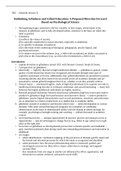TDC – Subotnik (lecture 5)
Rethinking Giftedness and Gifted Education: A Proposed Direction Forward
Based on Psychological Science
• the beginning stages, potential is the key variable; in later stages, achievement is the
measure of giftedness; and in fully developed talents, eminence is the basis on which this
label is granted
• Giftedness
(a) reflects the values of society;
(b) is typically manifested in actual outcomes, especially in adulthood;
(c) is specific to domains of endeavor;
(d) is the result of the coalescing of biological, pedagogical, psycho logical, and
psychosocial factors;
(e) is relative not just to the ordinary (e.g., a child with exceptional art ability com pared to
peers) but to the extraordinary (e.g., an artist who revolutionizes a field of art)
Introduction
• explain deviation in giftedness started 1921 with Terman’s Genetic Study of Genius
• 5 perspectives on giftedness:
1. historically → high IQ: directed at high intellectual abilities → giftedness is generic, innate
quality of individuals that needs to be recognized and revealed through some type of
cognitive assessment or IQ test, additionally, ther, gifted individuals are presumed to possess
reasoning abilities that allow them to be successful across all academic domains and are
presumed to remain gifted throughout their lives, whether or not they actually achieve
2. clinical nature → emotional fragility: study of high-IQ individuals to be superior not only in
intellectual functioning but also in volitional, emotional, and social functioning → many still
believed that highly intellectual individuals are highly sensitive
3. Renzulli proposed dichotomy between shool-house giftedness (high test score) and creative-
productive giftedness (high level performance and innovative ideas) →creative-productive
giftedness: psycho logical characteristics such as task persistence, creativity, and motivation
are as important to creative productivity as is intellectual or academic ability
4. giftedness outside of academics and beyond school years → talent development in various
domains: Elite sport and performing-arts programs are exemplary in combining
identification on the basis of demonstrated ability with the honing of talents through, for
example, psychological strength training and coaching → seldom discussed in academic
context
5. environmental factors → unequal opportunities & practice: practice and unequal access to
opportunities → special advantageous change factors (e.g. oldest in age cohort) or in right
place at the right time
• focus here on giftedness as developmental process that is domain specific and malleable →
goal: transform potential talent during youth into outstanding performance and innovation in
adulthood
• two stages:
1. talent identification: continuous targeting of the precursors of domain-specific talent and
the formal and informal processes by which the talent is recognized and identified
2. talent promotion: how the person demonstrating talent is instructed, guided, and
encouraged-a process too often left to chance rather than to strategic and targeted
societal effort
◦ that transitions from one stage to another are influenced by effort; opportunity; and
instruction in content, technical, and psycho social skills
, TDC – Subotnik (lecture 5)
Organization of the article
• emphasize of following key points:
◦ Abilities matter, particularly abilities associated with specific domains of talent. They
are malleable and need to be cultivated.
◦ Domains of talent have developmental trajectories that vary even within domains with
regard to when they tend to start, peak, and end.
◦ At every stage in the talent-development process, opportunities need to be provided by
the community (broadly defined to include school, neighborhood, local and regional
community, society at large), and opportunities need to be taken advantage of and
committed to by the talented individual.
◦ Psychosocial variables are determining factors in the successful development of talent.
◦ Eminence, which we characterize as contributing in a transcendent way to making
societal life better and more beautiful, is the aspired outcome of gifted education.
Defining Giftedness
• Giftedness is the manifestation of performance or production that is clearly at the upper end
of the distribution in a talent domain even relative to that of other high-functioning
individuals in that domain. Further, giftedness can be viewed as developmental, in that in the
beginning stages, potential is the key variable; in later stages, achievement is the measure of
giftedness; and in fully developed talents, eminence is the basis on which this label is
granted. Psychosocial variables play an essential role in the manifestation of giftedness at
every developmental stage. Both cognitive and psycho social variables are malleable and
need to be deliberately cultivated
◦ goal to be useful across all domains and acknowledges several perspectives about
giftedness
• highlighted points:
1. ability is necessary for giftedness but not sufficient for development of special talent
2. interest in and commitment to a domain are essential to becoming a gifted achiever and
ultimately to attaining eminence
3. gifted achievement and eminence also depend on appropriate teaching or coaching of
psychosocial skills that include persistence and exertion of effort
4. in every domain, the percentage of eminent adults is considerably smaller than the
percentage of children with gifted potential
5. developmental periods in which potential and eminence are recognized differ across
domains
6. transitions across stages—especially transitions through the later stages into adulthood—
are largely a function of developed psychosocial skills
7. emergence of new domains (e.g., snowboarding, programming applications for smart
phones and tablet devices) creates additional opportunities for the manifestation and
development of talent and eminence
Why are educator, scholars, and policy leery of giftedness and gifted education?
• This ambivalence is reflected in diametrically opposing societal attitudes and actions
associated with outstanding academic achievement
◦ examples of pervasive attitudes..
(a) beliefs that gifted children will make it on their own no matter what educational
environment they are placed in, leading to inconsistent funding for gifted education at
the state and federal levels (unlike other exceptionalities that also affect achievement,
such as learning or physical disabilities);





